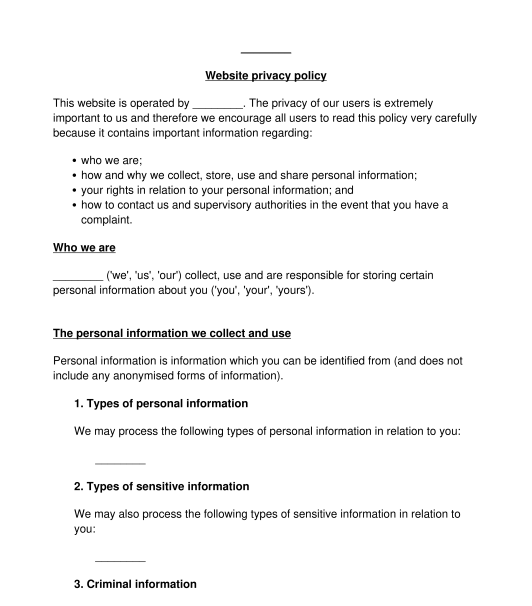 19/01/2025
19/01/2025

Answer a few questions and your document is created automatically.

Your document is ready! You will receive it in Word and PDF formats. You will be able to modify it.

You can choose to get help from a lawyer after filling out the document.




Option: Help from a lawyer
Rating: 4.6 - 81 votes
Fill out the templateA website privacy policy will be used by a UK-based website to provide website users with key information about the collection, use and storage of their personal data.
Yes. Data protection laws and regulations say that a website operator should tell their users what they will do with their data in simple and clear terms. It is therefore best to set this out in writing.
Personal data means any information relating to an identified or identifiable natural person (a data subject). It is therefore information from which a person may be identified directly or indirectly. Examples of personal data include a person's:
It is not necessary to sign a privacy policy. It can be finalised and placed on the website, in an easily accessible location. The website operator should ensure that important privacy information is placed at suitable places throughout the website, with a link to the privacy policy in appropriate places.
A website may also hold other policies and documents, which refer to or may be read alongside the privacy policy. This might include:
A privacy policy can remain in place indefinitely. However, the policy must be reviewed and kept up to date, as appropriate. The website operator should ensure the policy is updated if it changes how it collects, stores, shares or uses personal information. Typically, a policy of this nature will be reviewed annually.
A privacy policy will include information about:
The main legal provisions which apply to a privacy policy are:
The governing/supervisory body for upholding data protection rights is the Information Commissioner's Office (the ICO).
You can choose to consult a lawyer if you need help.
The lawyer can answer your questions or help you through the process. You will be offered this option when you complete the document.
You fill out a form. The document is created before your eyes as you respond to the questions.
At the end, you receive it in Word and PDF formats. You can modify it and reuse it.
Website Privacy Policy - Template - Word & PDF
Country: United Kingdom